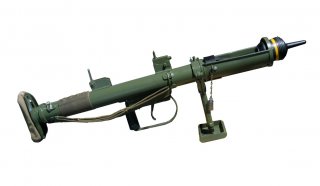Meet Britain’s Tank Killer: The PIAT Gun
Just as the tank solved the problem of mobility on the battlefield it created a new problem; namely how to stop enemy tanks in their tracks.
The PIAT could be carried by a single soldier, but typically it was assigned to a two-man team, with the second soldier carrying the ammunition and acting as the loader. This addressed one of the two aforementioned issues—the fact that it was rather heavy.
Loading and initial firing remained a complicated matter. While the PIAT could be fired from a prone or kneeling position, it all but required the user to stand to cock it. This was accomplished by unlatching the shoulder pad and then standing on it while pulling the rest of the gun up. By doing this the spigot and spring were latched into the firing position. The body was then slid back to the shoulder pad and latched. A projectile—or “bomb”—could then be placed in the tray at the front of the PIAT.
This method of cocking the gun, which did require a great deal of muscular strength, was only needed to be done for the first cocking before firing as it would automatically be re-cocked with each projectile. For soldiers in the field, however, this was not exactly the most welcoming way to arm the weapon. After the first shot, the spigot was re-cocked automatically—at least in theory.
Because of the weight of the PIAT, it was normally fired from the ground where the shooter utilized the integral folding support of the inverted T, which also served as a front grip. Aiming was achieved by using the folding aperture sights along with two or three apertures in the rear sight blade with ranges from 50 to 100 yards.
Firing the PIAT required at least two fingers to pull the trigger, and with each shot, there was a slight delay as the projectile ignited. This sometimes resulted in an inexperienced operator not holding the trigger long enough, which could result in the spring not fully re-cocking. In addition to the charge from the projectile, the movement of spring also shifted the weight of the PIAT, which the operator had to adjust accordingly.
Three types of PIAT projectiles (“bombs”) were available and included HEAT (high explosive anti-tank), White Phosphor and inert; the final one being for practice use. The bombs were supplied pre-loaded with launching cartridge and loaded into cardboard containers for transport.
Peter Suciu is a Michigan-based writer who has contributed to more than four dozen magazines, newspapers and websites. He is the author of several books on military headgear including A Gallery of Military Headdress, which is available on Amazon.com.
Image: Wikipedia.

